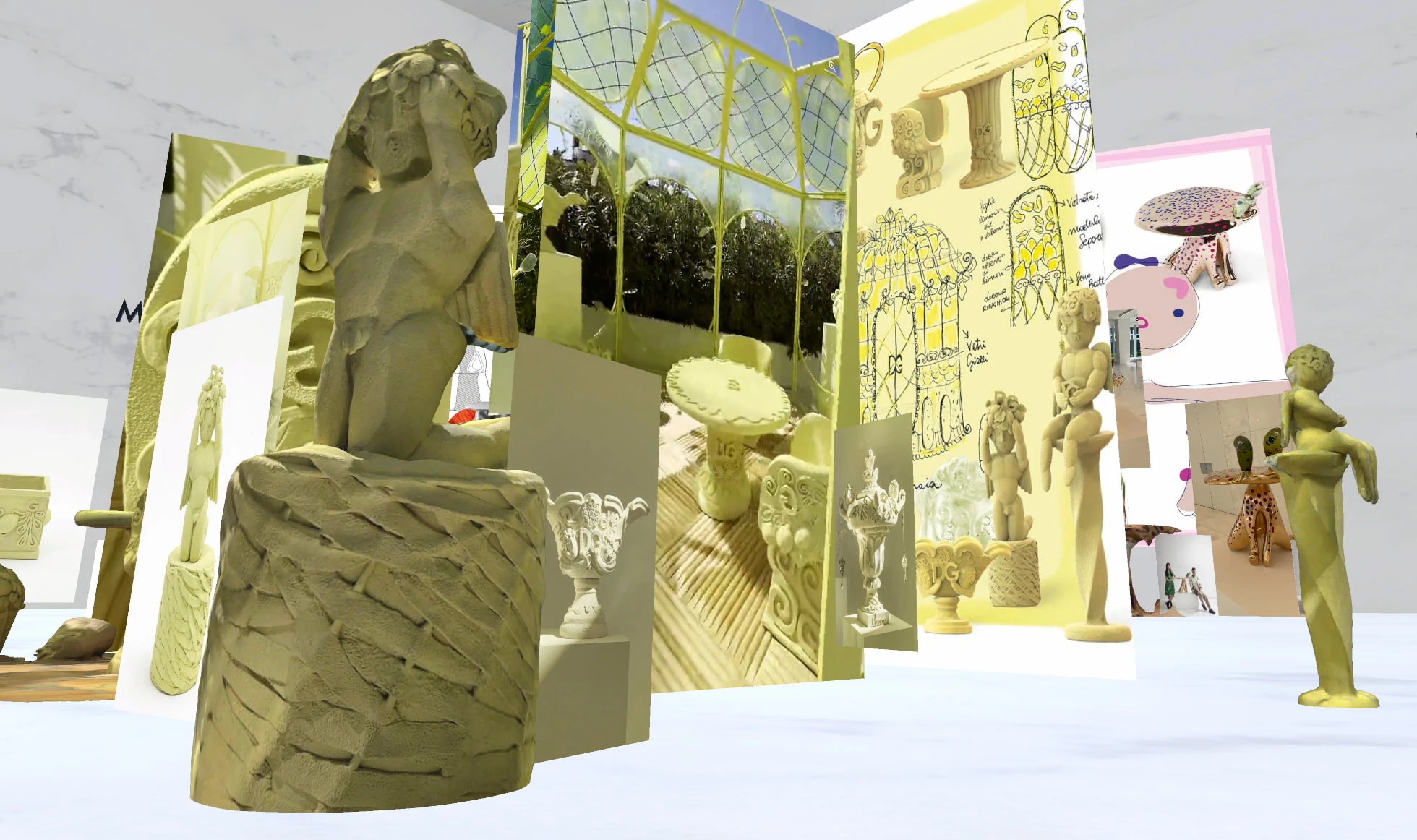
- Date
- 19 APRIL 2023
- Author
- GLORIA MARIA CAPPELLETTI
- Image by
- DOLCE&GABBANA
- Categories
- News
Gen-D Dolce&Gabbana's Fresh Take on Design with Emerging Talents
Welcome to Design Week 2023, where the city of Milan is bustling with innovative and exciting projects. Among the many proposals, we at RED-EYE have discovered the ultimate expression of tradition and vision for the future in the Gen D project. This initiative is a testament to the dedication of Dolce&Gabbana in supporting emerging talents. The project was curated by Federica Sala, a renowned curator in the field of high-end design research, known for her exceptional taste and proposals. Gen D is a project that embodies innovation and beauty, reflecting the desire for a better future.
Gen D, or Generazione Designer, is a project that was born out of the desire of Domenico Dolce and Stefano Gabbana to translate their forward-looking approach into the field of furnishing, just as they have done in their fashion brand over the years. The project aims to actively support the talent of young designers, with the goal of creating cultural bridges between the company’s generous creativity, its ties with Italy, and the rest of the world.
Ten designers were selected by Federica Sala, and they come from different parts of the world. However, almost all of them are individuals who are straddling two worlds, and it is precisely this flexibility that was the key to their selection. The Korean ceramist Ahryun Lee, who is based in Germany; the American designer Chris Wolston, who lives and works in Medellin, Colombia; the Lebanese duo Sayar&Garibeh, currently residing in France; the Venetian designer, but long-time Londoner, Lucia Massari; and the former finance guy Malacou Lefebvre, who abandoned numbers to open the creative carpentry workshop Atelier Malak in Lyon. These are just a few examples of the young designers who are promising new talents in the world of design. Some of them are active in their hometowns, while others are striking a balance between North and South or East and West, reflecting their mixed cultural heritage.
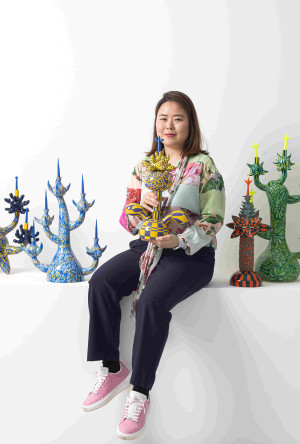
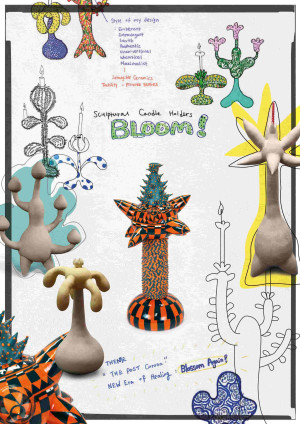
AHRYUN LEE
What is your background?
Ceramics, playing in different territories whilst blurring down the boundaries in between Art and Design and Craft.
How did you choose the artisanal practices and materials for your design project?
As I am specializing in ceramics, I stick to my material. I primarily work with porcelain, which is the most refined, delicate materials in terms of tactility and creating bold colors, but for this project I was not only working with porcelain but also using Italian clay from Sicily provided by Sicilian ceramicists. I learned new techniques from them - Italian Majolica - and embraced this Italian tradition to my contemporary work. Each piece is unique, one-off. Everything was individually hand-built and hand painted.
And how was your experience working with Dolce & Gabbana?
It was a fantastic collaboration with Dolce&Gabbana. Domenico and Stefano supported me a lot to boost my creativity and develop my ideas into real vision. Also, they offered me an artist residency in Sicily, which was an incredible journey in 2022, where I met Italian artisans to learn something new and bridging my culture into different Italian culture. I had a high appreciation of Italian Beauty and I miss Sicily so much, I had a great cultural experience there. Sicily itself became my biggest inspiration in development of this GenD project. It was so much fun and supportive project ever.
What is the main concept and inspiration behind your design project and what message do you want to convey to the audience?
As I mentioned above, I put all my memories from Sicily in my project. Highly inspired by this beautiful land – natures, botanical gardens, alive feelings – I focused on the sense of memory of Sicily as a part of my nostalgia to capture these feelings into the objects. I choose to create a series of sculptural candle holders – a symbolic, spiritual objects hoping for a resilience from a difficult time of Covid. I wanted to bring "Optimistic Joy" in the object with lots of colors and patterns after having been through such an unusual time. For the audience, I hope my fun, eye-catching, maximalist object can give a hint of joy in our daily lives and people can taste the sense of Sicily when gazing upon my ceramics.
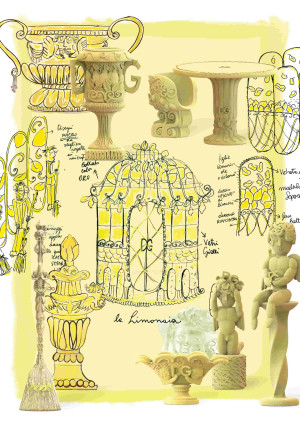
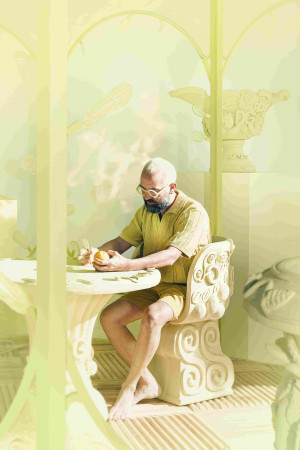
ANTONIO ARICO
What is your background?
I have studied Product/Fashion Design at Politecnico di Milan. Then, I worked for few Milanese studios when I decided to go back to my family expertise that is wood; so, I started to present few collections in Milan created with my grandfather who is a carpenter.
How did you choose the artisanal practices and materials for your design project
I love to work with simple and natural materials and to transform them in something very precious. I think this is the perfect recipe of Italian design. So, I have chosen to work mainly with terracotta from Impruneta, Tuscany, and throughout Italy with peculiar techniques from different regions.
And how was your experience working with Dolce & Gabbana?
It was nice as the project was curated in every single detail to build bridges between creatives and Italian artisans.
What is the main concept and inspiration behind your design project and what is the message you want to convey to the audience?
We can start from values and archetypes from the past and make them alive and strong at our days.
Luxury and simplicity they can go together to create a dream.
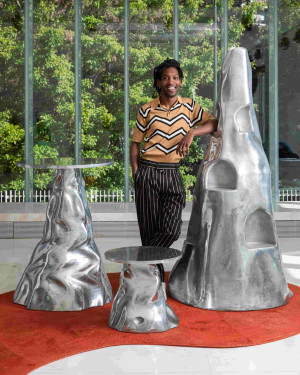
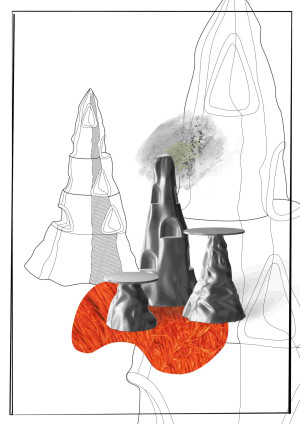
MALACOU LEFEBVRE
What is your background?
My first professional life was in finance after studying business. I stopped it 4 years ago to create by own workshop and to dedicate my life to creation and exploration of shapes and materials.
How did you choose the artisanal practices and materials for your design project and how was your experience working with Dolce&Gabbana?
I have chosen to explore new technics to answer, at the same time, esthetical wills and ease of day life use (material weight). Thus, we sculpted foam and then burned it to give it its contrasted and textured surface. After that, we projected molten metal on it. About the carpet, we worked and cut leather to make it seem like earth and grass.
It was kind of a new challenge for me because I’m used to work by myself. This time, I had to be the most specific I could give artistic indications. It was a really great experience, a deep connection to Italian know-how.
What is the main concept and inspiration behind your design project and what is the message do you want to convey to the audience?
The Palaver Garden installation wants to explore the meaning of the Palaver Tree, what makes it so significant, what gives its power to gather people. This first approach leads me to consider its symbolic charge, beyond its capability for shading.
To synthesize this symbolic force, relying on the totemic aspect of the Palaver Tree, I wanted to create a sensitive furniture by its shape, and powerful by its allegoric resource. To meet these two goals, I designed 3 pieces that, all together, describes a landscape, offering an evolutive scenery (the reflection of the surfaces enhances this aspect). In the tallest sculpture, each user can integrate objects that are emotionally linked to them. The carpet, on the ground, by its large and organic format, invites for gathering and share space. The two other elements can be perceived as seating or table. The further this idea got, the further I saw it at the interface of the idea of contemplation conveyed by a Japanese garden and the gathering power of the Palaver Tree.
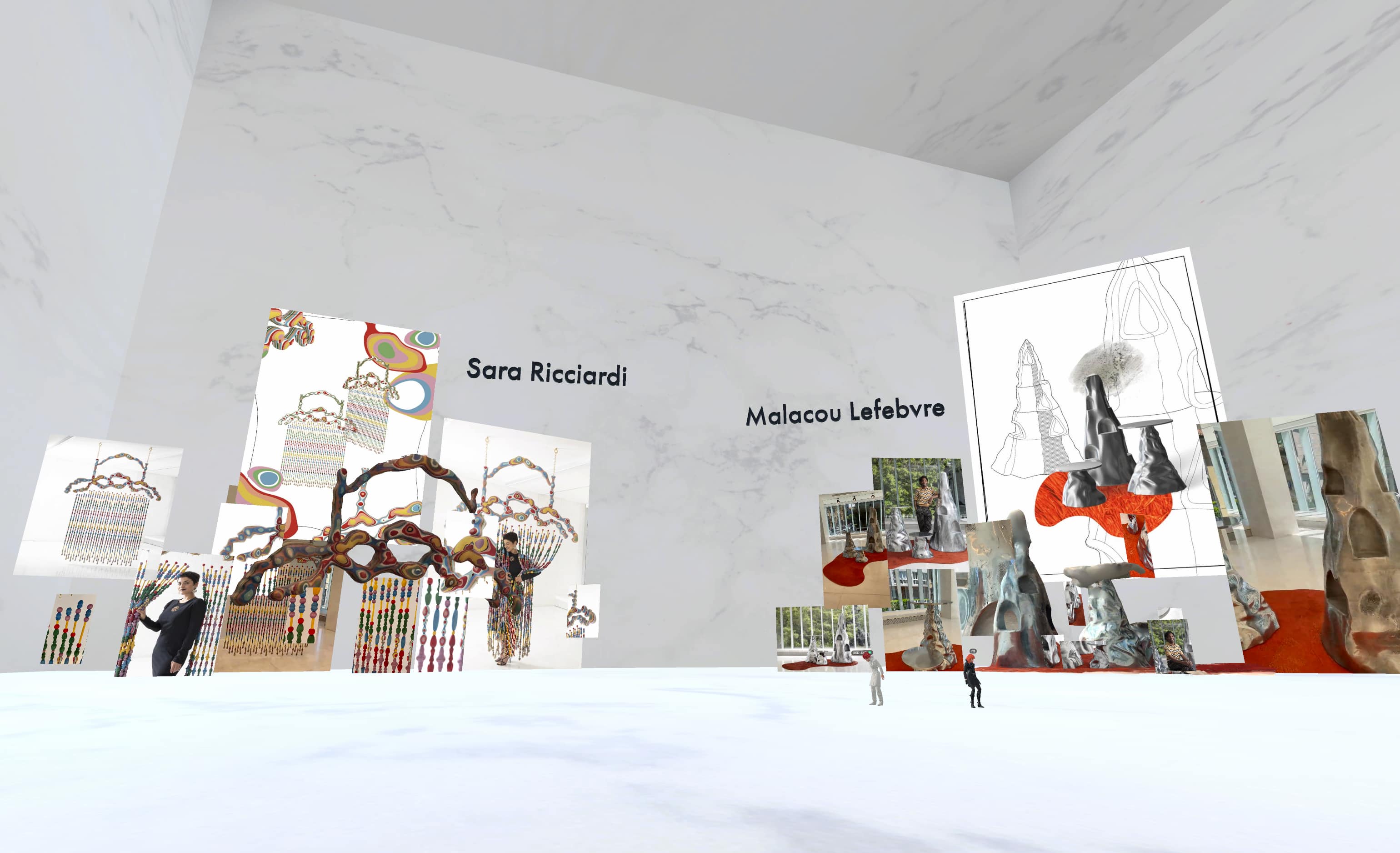
Gen D is primarily a project of artist residences, or rather designer residences, which has allowed these ten upcoming talents to explore some of the main Italian craftsmanship techniques under the banner of Dolce & Gabbana’s energy, explosion of colors, and ironic elegance. Depending on their previous skills and individual desires, the designers were given the opportunity to work with Murano blown glass, Sicilian ceramics, metal carpentry, woodworking, handmade terracotta, wickerwork, wrought iron, metal casting, and the now-rare technique of enamel on metal.
These projects were born out of complete freedom, which allowed the designers to exchange ideas and collaborate with the company's DNA, the creative richness of our country, and the importance of manual craftsmanship. This project is a continuation of Dolce & Gabbana's tradition of supporting young talents, as the brand has always believed in nurturing the next generation of creatives in various fields. Gen D is a testament to the company's dedication to excellence, creativity, and innovation.
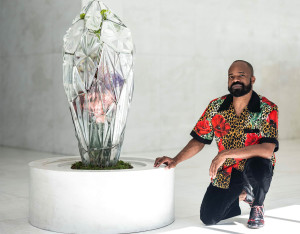
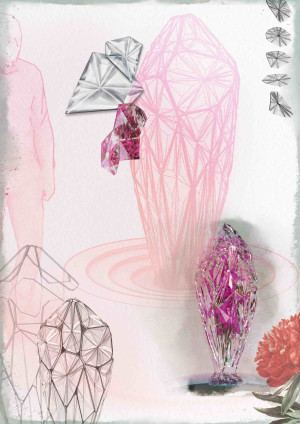
BRADLEY BOWERS
What is your background?
I started out as a painter, and then studied industrial design for my undergraduate degree, and then studied furniture design for my master’s degree.
How did you choose the artisanal practices and materials for your design project and how was your experience working with Dolce&Gabbana?
Because this was such a unique opportunity, my goal was to work with a material and an artisan that I would not have access to, otherwise. So, I chose Venetian glass, it's a material I have not explored personally in my studio, and I love a material that incorporates multiple properties like glass's, ability to play with light and color and texture all at the same time. And how many times will you get a chance to go to such a historic place as Venice, and work with maestro's that have centuries of knowledge?
Honestly, the team at Dolce&Gabbana, and Federica Sala, have been beyond fantastic. They made sure that the creative vision that I originally was excited by was maintained throughout the entire process. And I think they took real pride in helping bring the work to life!!
What is the main concept and inspiration behind your design project and what is the message do you want to convey to the audience?
With my project, Fiosa, I am using glass and it's natural optical properties to create a surreal experience.
Typically, a flower vase and the flowers it contains are not very related, but I wanted to make sure that with Fiosa, the flowers and the vase were in constant dialogue! Because of its complex geometry the glass prisms create abstracted 'paintings' of the flowers within. As you look through the vase each flower, and bloom, and leaf is transformed into a splash of color. So anywhere you stand you see something completely different than where you were before.
My goal with all my work is to show people something that they've never thought of before, something sublime.
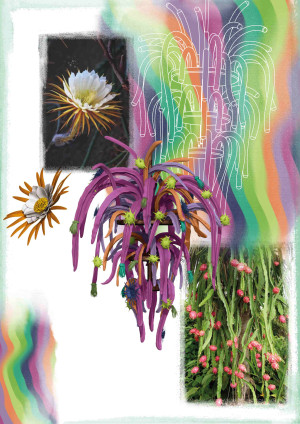
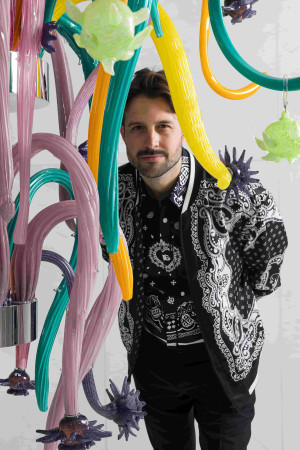
CHRIS WOLSTON
What is your background?
I grew up in Rhode Island and lived in New York for years before moving to Medellin, Colombia, on a Fulbright Grant and setting up my residence and studio there.
How did you choose the artisanal practices and materials for your design project
I worked with a glass fornace in Murano and a ceramics studio in Sicily. I was interested in combining two disparate traditions, both distinctly Italian, into a singular piece.
And how was your experience working with Dolce & Gabbana?
DG offered their vast list of Italian craftsmen, and manufacturing expertise to help facilitate anything and everything I wanted through the entire creation process. The company fully supported the creative visions of the individual artist and the realization of everyone's distinct vision. Domenico himself was involved in the process and very supportive about pushing the work to the furthest extent needed to see the principal vision realized.
What is the main concept and inspiration behind your design project and what is the message you want to convey to the audience?
In the spirit of cross-cultural dialogue, I was interested in combining the typical pop aesthetics inspired by my garden in Medellin, with distinctly traditional Italian craft techniques. Exploring the history of Venetian chandelier making, I drew connections to Pitaya Cactus vines and their ephemeral, delicately complex flower, which blossoms for a single night. I was also interested in the company's roots and aesthetic connection with southern Italy, so I worked with a traditional Ceramics studio in Sicily to create decorative elements that adorned the Venetia glass.
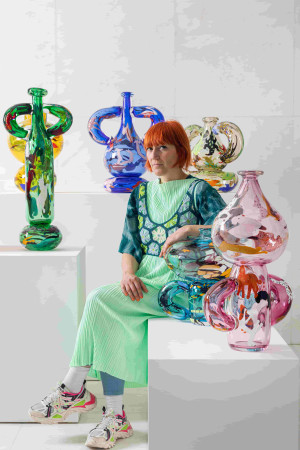
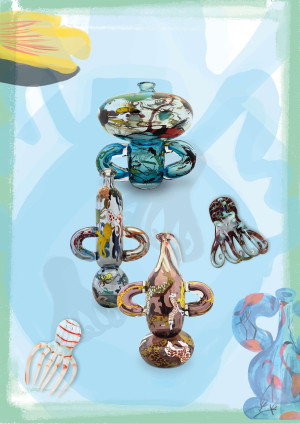
LUCIA MASSARI
What is your background?
I have a bachelor's degree in product design from the University of Architecture in Venice. After graduating, I worked in a graphic design studio to finance my studies and consolidate my own language by developing my portfolio; this year also helped me shape my interest in design: graphics, colors and drawing are very evident in my language.
Then I moved to London to do a Master's degree in Product Design at the Royal college of Art, where I studied under the guidance of Martino Gamper and Jurgen Bey.
How did you choose the artisanal practices and materials for your design project?
In the most recent years, I have been working persistently with glass, this is such a medium that I feel comfortable with, and at the same time it's extremely challenging; it stimulates me to go deeper and explore the possibilities that it offers. When DG offered the freedom of exploration, I was 100% certain where to go.
And how was your experience working with Dolce&Gabbana?
It was beyond amazing, I worked on commissioned projects, but I never experienced such freedom of movement.
There are no other forms of jobs that offer you the freedom that art is giving you, and when all the doors are being open for you, and your personal investigation, it is a colossal privilege.
What is the main concept and inspiration behind your design project and what message do you want to convey to the audience?
In the Murano manufacture, animals were a source of inspiration for the great masters, a subject worthy of technical and formal experimentation, but with the advance of mass tourism, the glass animal has become almost a symbol of cheap Venetian souvenirs, sometimes of dubious quality, origin, and taste.
By the word animalier we mean all those prints that come from the animal world, and with this project I wanted to use the animals that populate the windows of the souvenir shops as a kind of readymade to recover the glass that has unfortunately become a kind of visual junk.
Using the same technic handed down to make murrina vases, the various glass objects are heated and collected by the master in the molten blob of glass, in this way they are inserted into the mass that, once worked and blown, will cause them to twist, turning the vase into a zoo, a kind of fantastic bestiary composed of animals deformed by the same manufacturing process of the material, in Animalier it is the material that decides and creates its own covering.
This act transforms three-dimensional objects into a two-dimensional decoration, a pattern, a repeating loop around a series of blown vases.
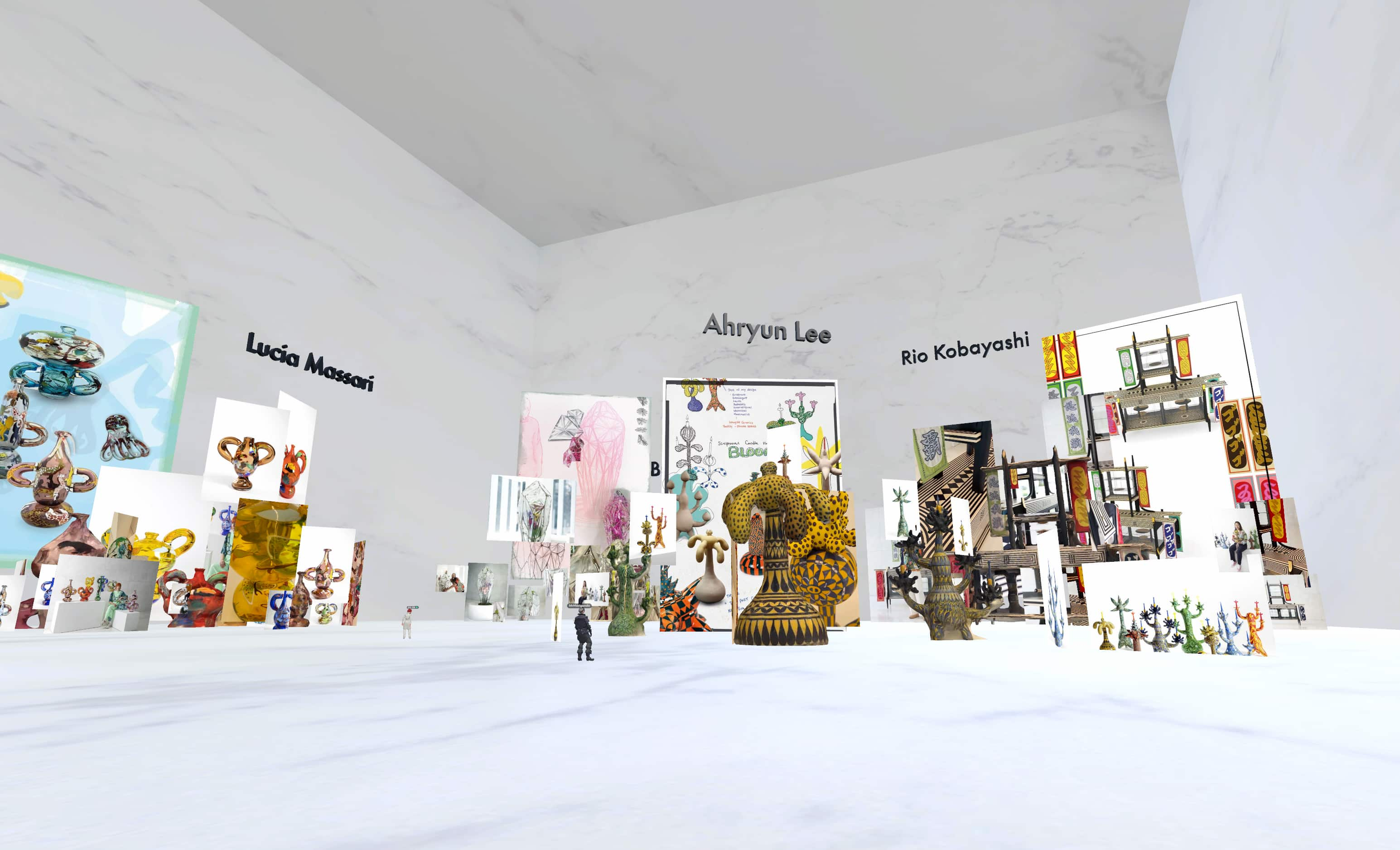
The result of the Gen D project is simply outstanding! These exceptional and elaborately complex pieces often introduce innovative techniques in production and have seen the young designers actively involved in the manual creation of these pieces. Not only that, but they also showcase how these designers have interpreted the key elements of the Dolce&Gabbana brand with their own unique style. These cultural bridges are a nod to how we live today and bring into our homes furnishings that are almost like jewels with which to face our daily lives. They are contemporary chimeras, triumphs of lemons and jewel brooms, celebrations of souvenirs and light-up cacti, sensory curtains and kaleidoscopic vases... Each piece is a work of art that is both beautiful and functional, bringing an undeniable Italian flair into our living spaces. We at RED-EYE cannot wait to see how these young designers continue to shape the world of design and create even more breathtaking pieces in the future.
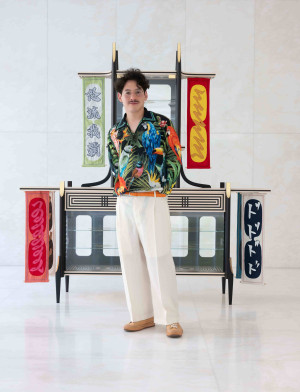
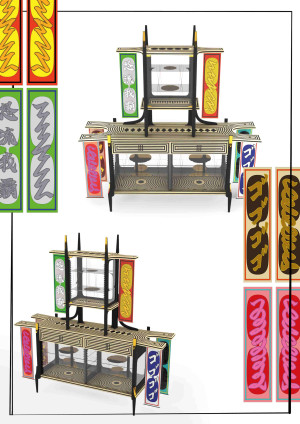
RIO KOBAYASHI
What is your background?
My background is wood working. My father is Japanese, my mother is Austrian/Italian, and I grew up in the Japanese countryside in Mashiko, Tochigi.
When I was 18, I travelled to Austria where I mastered my woodworking skills. Then I lived and worked in many places such as Milan, Berlin, Paris, Porto, Basel and in 2017 I set up my own praxis in East London.
How did you choose the artisanal practices and materials for your design project
I grew up in an artisanal family environment, my father is a potter and my mother is a conservationist and the gilding master; they build houses for themselves in the countryside in Tochigi Prefecture.
In this environment, making things was essential and woodwork and tools were always around me. When I was 16-17 it was clear that I wanted to become a designer and since then I followed the path to make wood my work. But I am very curious to work with other materials such as glass and textiles and I am so glad that this project gave me a bit of an insight to the new material world.
And how was your experience working with Dolce&Gabbana?
Working with DG gave me chance to explore another level of craftsmanship and materials which I have never worked with before.
Also, I have learned a lot about working with other people as most of my projects, so far, were created by my own hands and this time I was mostly working on 3D drawings and creating clear communication materials such as presentation sheets and technical drawings. It made me realize how important this part is for the happy result.
Through this project I have met and made friends with some amazingly talented people, I had amazing feedbacks and strong supports of my friends and family.
What is the main concept and inspiration behind your design project and what is the message do you want to convey to the audience?
As my background is wood working, the first time I saw the DG Casa collection last year, I really liked the zebra collection and the very bold and graphical contrast it creates. I liked the ambiguity of the zebra as an animal, the black and white, it has the element of both and it is a totally different specie, which I can easily reflect on my personal cultural stories. I wanted to explore the decorative and graphical approach with wood which I came up with marquetry.
The idea of Shima Uma is that I wanted to create a piece which celebrates and reflects this entire project. DG has invited 10 designers from all over the world, from different cultural backgrounds, to come to Italy and gave us a chance to push our limit of designing a new collaboration with the local highly skilled artisans. But also combining my own experiences as a multicultural background. So, my piece has the element of the European part like Vienna secession, wiener werkstätte/ Josef Hoffman/ koloman moser on the high-quality marquetry part as the shape of Charles Rennie Mackintosh or Frank Lloyd wright. Those triangle shaped Legs are inspired by one of my favorite chairs from Italian architect Gio Ponti called Superleggera. The work gives you the feeling of warrior / Victory, so I made a gold plated shape in the glass shelving and it has the typical shape of the parts of the samurai sword which are the most Important parts to protect the hand from the attack from the others. Using textiles in this piece was essential as DG is originally uses Textiles for their luxurious garments. Fashion with slightly provocative brand image reminded me of my experience back in the day. There is a special fashion culture for the youth rebels when they graduate their school they often amend/tailor make their school uniform and embroider their name and dates and years, teams name and some memories etc. on the garments and they often use some aggressive character to provoke teachers and their enemies. On the one Flag it says DO RU GA BA which is a short form of calling Dolce&Gabbana only in Japan, but I borrowed the different character which shares the pronunciation but has the aggressive meaning. In the other flags there is some Japanese writing of sound as DODODODO or GOGOGOGO. It's often used in the background sounds of scenes in the comics. As POW!! POW!! or BOOOM!!! in this way I wanted to make it more comical and creates the balance of other provocation with the other writing. And there are some other strokes and those are there to just trick the people, but it has no meaning.
I wanted to engage many cultures, languages, backgrounds, and ideas into a piece to celebrate all this. Also tried to open people’s mind to accept the diversity of the planet. Awakening curiosity in many different directions is the key to follow your passion and happiness, fun and of course world peace!
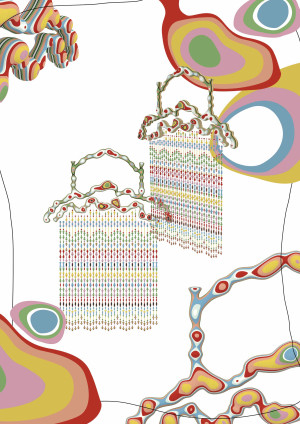
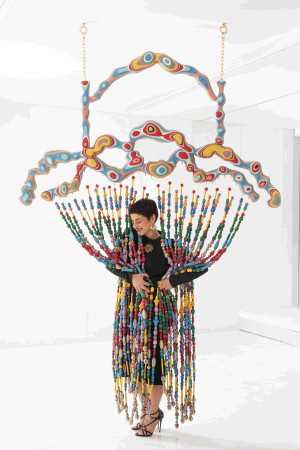
SARA RICCIARDI
What is your background?
I’m a witch and a designer from South of Italy but my studio now is based in Milan working with installations products and interiors - I love books and confetti. I collect stones and feathers, I’ve been studying product design between Milan, Istanbul and NewYork. Before drawing a dance and I work a lot with materials and techniques from all around Italy
How did you choose the artisanal practices and materials for your design project and how was your experience working with Dolce&Gabbana?
Working for this brand for me was a huge possibility because I remember the first speech from Domenico, he told us: please design with your belly - use your passion and find the shape. We could really express ourselves experimenting with techniques that are very difficult to work with, we have been able to work with very peculiar craftsman to give birth to the bizarre I had inside.
I was working with layers of colorful wood carved to create this crazy shape for my curtain.
What is the main concept and inspiration behind your design project and what is the message do you want to convey to the audience?
Whenever I think about the sounds that remind me of my beloved Southern Italy there is the one of wood beaded curtains. Hung in the entryways to protect domestic intimacy and to create that relaxing sound while passing by.
Feeling the presence of someone even just with the sound and seeing them emerge from the beads arranged in geometric patterns. I remember every grandmother having had one.
For Dolce&Gabbana I wanted to reinterpret this element and bring it to a festive dimension, mixing the aesthetic of Luminarie (luminaries) – light systems that are used to decorate Sicilian and Southern Italian towns during their patron saint’s days.
And so, in this combinatory spirit I decided that these two classical elements must be combined with love in order to give birth to: Luminaria – a curtain, a gate, a divider, a code, a theatrical stage.
It is made entirely of wood, combining layers of colored heartwood sculpted with a numerical control and hand polished. Great mastery behind this colorful piece that is full of joy. Happy shades that smile, joyful and all decked out so that the everyday can become a most beautiful party.
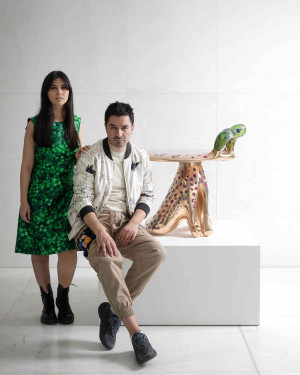
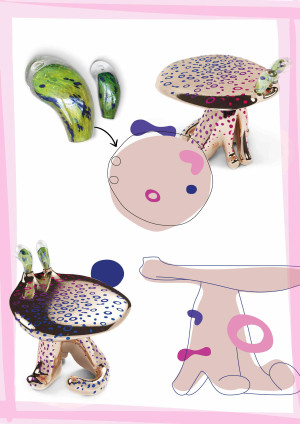
SAYAR & GARIBEH
What is your background?
We are Stephanie Sayar & Charbel Garibeh, Lebanese-based designers, currently living between Paris and Beirut; we work together as a team, to complete projects where each have individual opinions and personal touches, combined to create fictional and functional pieces.
Our approach to design encompasses our combined vision of naïve and experimental design with a dash of humor using new materials and forms. We create our identity through everyday life experiences, creating bridges between local craftsmanship, artisanal scene, and design.
Our pieces are hybrid, we collaborate with artisans using traditional techniques as well as we create our own pieces using their skills, depending on the need of each piece.
We realized the necessity of designing together after three years of graduating with a Master’s degree in Interior Architecture, since then, we carved out a distinctive aesthetic, combining organic and geometric forms with traditional crafts and whimsical anthropomorphic touches.
Working together is always fun, and while communication is one of the main elements in our method, we can't hide the fact that it sometimes gets messy, but it's all part of the ride... We tried to work separately a few times [in the beginning] but we always ended up realizing that there was something missing.
How did you choose the artisanal practices and materials for your design project?
We wanted to explore the Italian craft as much as we can and make the most of it. So, we had the concept of playing with fire, basically we ended up picking 3 artisanal disciplines based on fire: Blown Glass / Casted bronze / Glass enameling.
We chose to highlight and play with fire at different levels, starting from glass blowing to sculpting, casting bronze and glass enameling. We wanted to create a tempting jewelry piece, a celebration of Italian authenticity, by focusing on the glass enamel on bronze, an old forgotten technique, created firstly in the Mediterranean area before spreading to the rest of the world. A process of imparting a vitreous glaze to a surface through intense heat. It has been reported that gold rings excavated from a Mycenaean tomb from 13th century BCE featured enamel technique.
Coming from a Mediterranean country, it’s a reflection of our roots mixed with an ancient Italian culture and know how. It’s an awakening of a dying decorative tradition. As for the bronze casting, we used the lost wax process which is a traditional technique also used for jewelry making.
And how was your experience working with Dolce&Gabbana?
It was such a great opportunity to work with Dolce & Gabbana, with a “Carte blanche” to dream and create and also meet a large circle of Italian artisans.
What is the main concept and inspiration behind your design project and what message do you want to convey to the audience?
Raytoid low table reflects different pleasures and emotions in life. It’s an exploration of nature, sexuality, and humor inviting touch and different other senses. The design is an escape into another reality. It ignites a smile. It’s humorous, playful and colorful. It’s a statement piece, an anthropomorphic shape, giving the table a ludic character, of an enchanting creature coming from the “Arcturus” star system.
Will keep on dreaming!
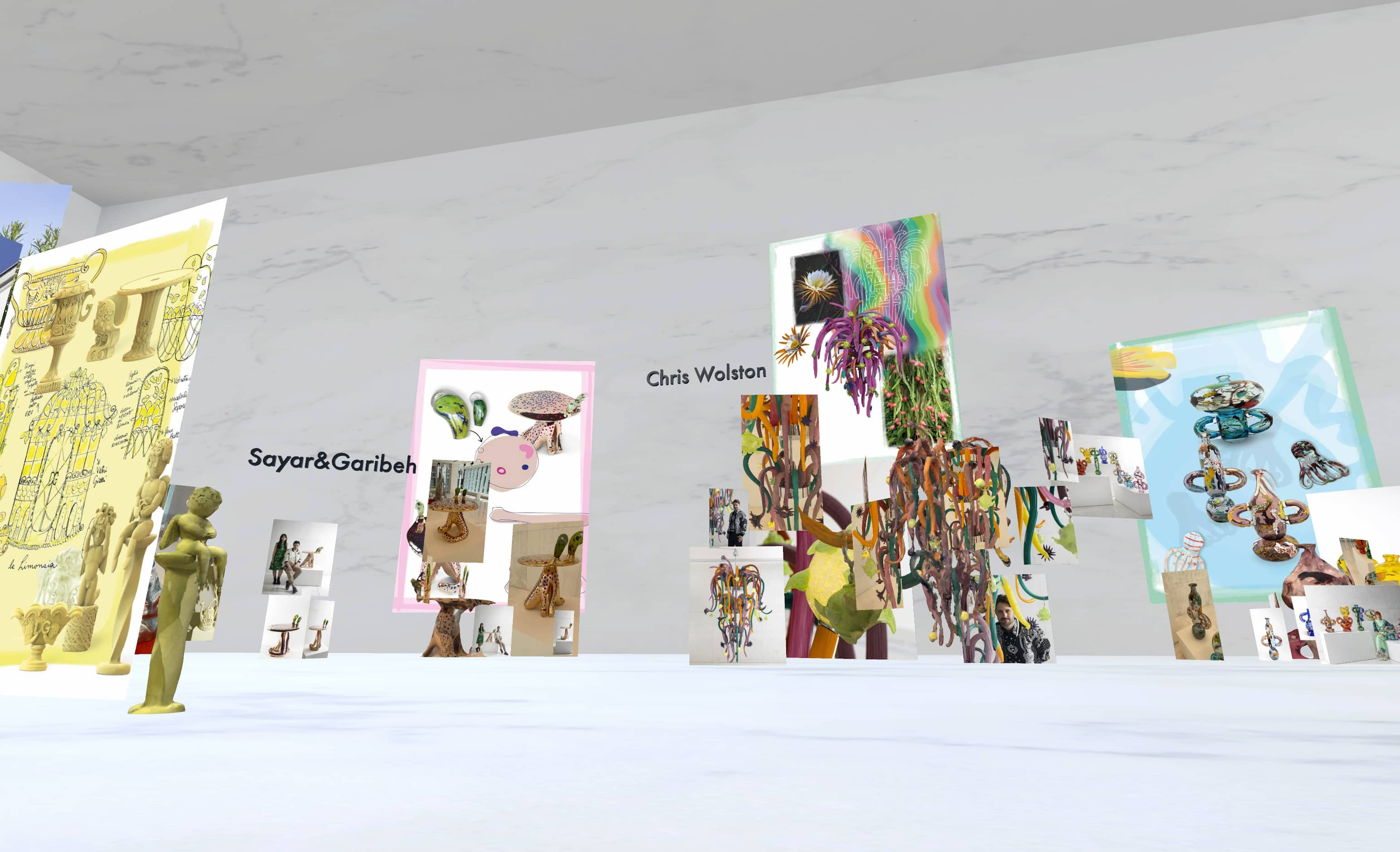
At RED-EYE, we are so impressed and excited about the Gen D project that we have decided to showcase the incredible works of these young designers in a virtual exhibition on our metazine in Spatial. We want to share with the world the beauty and innovation that Dolce&Gabbana and Federica Sala have brought to the world of design through this project.
We believe that the creations of these talented individuals have the power to inspire and amaze people from all corners of the world. Their works are not just furniture or decor pieces, but true works of art that blend tradition and modernity, Italian craftsmanship and global creativity.
Through our virtual exhibition, we aim to create a platform for these young designers to showcase their unique styles and talents to a global audience. We hope that this will help them to reach new heights in their careers and continue to create amazing works that push the boundaries of design.
The Gen D project by Dolce&Gabbana is a true celebration of creativity, innovation, and cultural exchange. We are honoured to have the opportunity to showcase the amazing works of these young designers in our virtual exhibition and we encourage everyone to check it out and be inspired by their talent and vision.
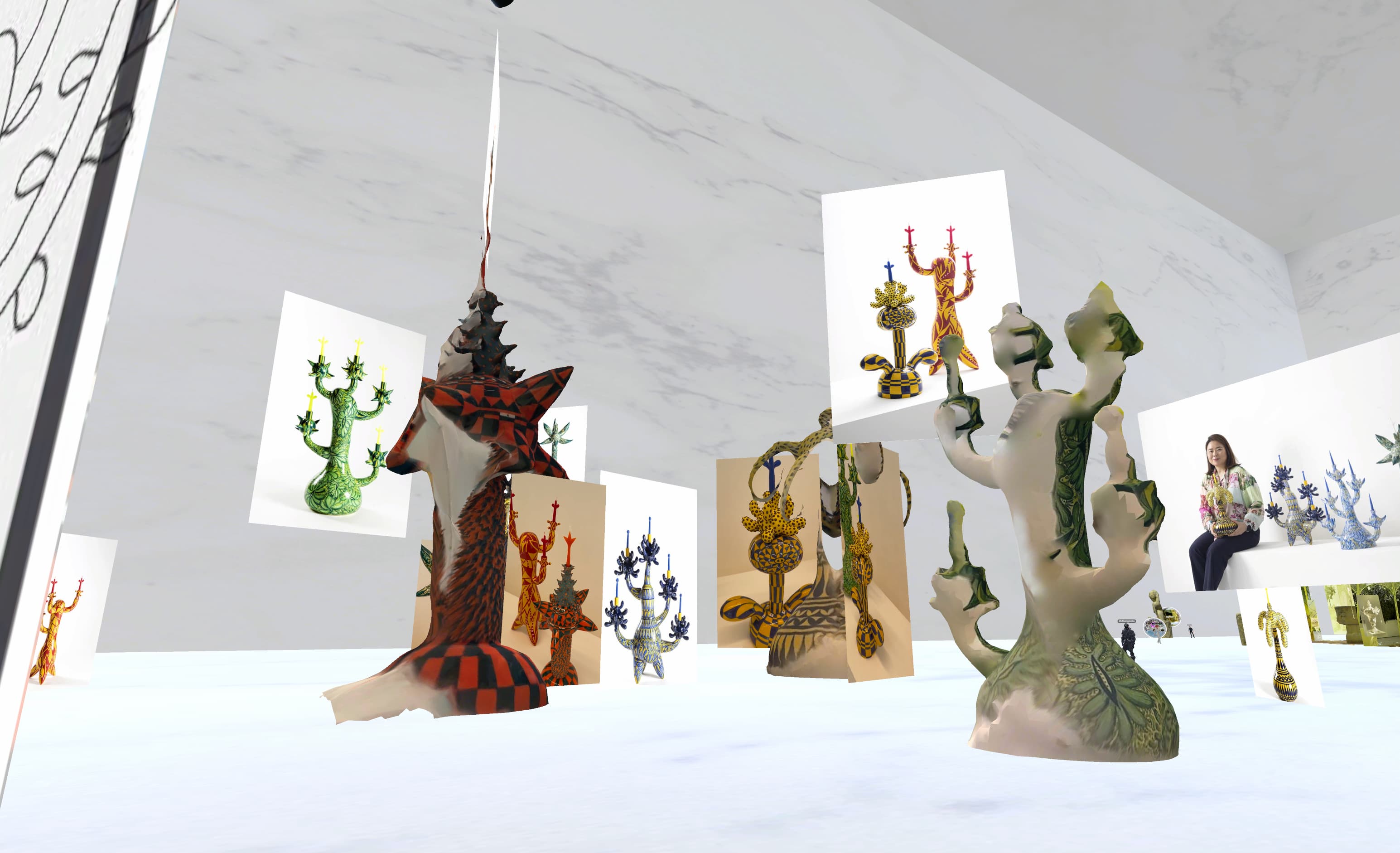
AI Words Edited by Gloria Maria Cappelletti
Images Courtesy of Dolce&Gabbana Press Office
3D Scans and Videos by RED-EYE Editorial Team
Metaverse Design by Martin Romeo
3D Graphics by Tanya Pletneva